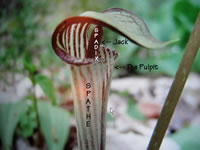How to Grow and Care for Jack in the Pulpit Plants
Arisaema species
        
The genus Arisaema consists of about 150 species of distinctive, rhizomatous or tuberous,
woodland wildflowers that are native to North America and parts of Asia.
They are commonly known as Jack in the Pulpits or sometimes called Cobra Lilies.
These 12"-30" tall plants consist of one or two compound, green or sometimes variegated leaves
that are divided
into 3-30 leaflets each, depending on the species.
In spring to early summer, tiny, insignificant flowers form on the spadix (Jack), hidden down
inside the hooded spathe (The Pulpit), which emerges from the middle of the foliage.
The size and coloring of the spathe and spadix varies considerably, depending on the species.
Male flowers produce yellow pollen which is distributed onto the white, female flowers by flies.
Tight clusters of small,green berries form along the spadix, that ripen to scarlet red in the fall.
All parts of Jack in the Pulpit plants should be considered toxic!
|
These unique plants are an excellent addition to any shade or woodland garden.
For a listing of different Arisaema species, visit the Wild Ginger Farm
Growing Requirements for Jack in the Pulpit Plants
Jack in the Pulpits are easy to cultivate and care for plants that tolerate a wide variety of conditions, but grow and thrive best in moist, shady locations.
For the best results, plant them in slightly acidic, evenly moist, well drained soil that has been enriched with compost, peat moss, or other decayed organic material at planting time.
Excessively wet soil in the winter may cause the underground parts of the plant to rot.
Hardiness zones vary by species, but most Arisaemas are frost hardy. |

|
Propagating and Growing Jack in the Pulpits from Seeds
Jack in the Pulpit plants can be propagated by digging and dividing the rhizomes or tubers in the winter,
or by removing offsets from the parent plant.
|
|
|
Arisaema seeds require a cold stratification period for germination, so in warm winter regions or if sowing the seeds indoors, you will need to place your freshly cleaned seeds in a plastic bag with some potting soil and refrigerate them for 6-8 weeks before planting.
Jack in the Pulpit seeds can be collected once the spathe has died back in the fall and the berries are fully ripened.
Wearing gloves to protect your hands from irritation, remove the berries from the pod and clean the flesh from the seeds.
These seeds do not store well, so they should sown or stratified as soon as possible.
Seeds may be sown outdoors where you want the plants to grow, in the fall.
Cover the seeds with ¼" to ½" of fine, lightly moistened soil.
Jack in the Pulpits grown from seed may take several years before they are mature enough to flower, but the plants can live for as long as 20 years!
|
Jack in the Pulpit

Arisaema triphyllum |

Arisaema flavum |
|
|
|
Search The Garden Helper:


